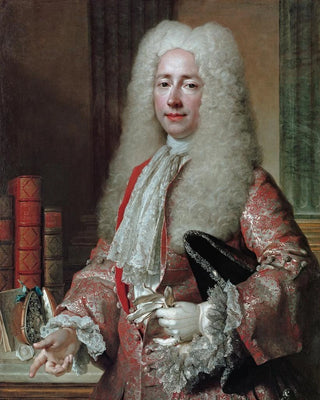Art print | Portrait of Conrad Detlef Count of Dehn - Nicolas de Largillière


View from behind

Frame (optional)
The "Art print of Conrad Detlef Count of Dehn" by Nicolas de Largillière is an iconic piece that embodies the elegance and refinement of the 18th century. This painting, with its striking realism and attention to detail, transports the viewer to a time when nobility was at its peak. Largillière, an undisputed master of the portrait, manages to capture not only the physical appearance of his subject but also the very essence of his personality. Contemplating this work, one feels an intimate connection with history, as if the Count of Dehn were telling his own story through his gaze.
Style and uniqueness of the work
The piece stands out for its masterful use of light and color, creating an atmosphere that is both lively and timeless. Largillière excels in depicting textures, whether it is the rich velvet of the count's costume or the delicate reflections of his accessories. The choice of colors, both vivid and nuanced, adds emotional depth to the portrait. The posture of the count, both majestic and approachable, demonstrates a skill in establishing a dialogue between the subject and the viewer. Every detail, from the fold of his shirt to the sparkle in his eyes, is carefully crafted, revealing Largillière's virtuosity and his desire to transcend the simple portrait to offer a true work of art.
The artist and his influence
Nicolas de Largillière, born in 1656, is often regarded as one of the greatest portraitists of his time. His career, spanning several decades, was marked by a stylistic evolution that reflects the changes in French society. As an artist, he skillfully navigated between Baroque influences and the beginnings of Rococo, creating a unique style that allowed him to stand out. His work not only influenced his contemporaries but also left a lasting imprint on subsequent generations. Largillière was able to highlight the psychology of his models, making each portrait not only a visual representation but also a study of character. This Art print of Conrad...

Matte finish

View from behind

Frame (optional)
The "Art print of Conrad Detlef Count of Dehn" by Nicolas de Largillière is an iconic piece that embodies the elegance and refinement of the 18th century. This painting, with its striking realism and attention to detail, transports the viewer to a time when nobility was at its peak. Largillière, an undisputed master of the portrait, manages to capture not only the physical appearance of his subject but also the very essence of his personality. Contemplating this work, one feels an intimate connection with history, as if the Count of Dehn were telling his own story through his gaze.
Style and uniqueness of the work
The piece stands out for its masterful use of light and color, creating an atmosphere that is both lively and timeless. Largillière excels in depicting textures, whether it is the rich velvet of the count's costume or the delicate reflections of his accessories. The choice of colors, both vivid and nuanced, adds emotional depth to the portrait. The posture of the count, both majestic and approachable, demonstrates a skill in establishing a dialogue between the subject and the viewer. Every detail, from the fold of his shirt to the sparkle in his eyes, is carefully crafted, revealing Largillière's virtuosity and his desire to transcend the simple portrait to offer a true work of art.
The artist and his influence
Nicolas de Largillière, born in 1656, is often regarded as one of the greatest portraitists of his time. His career, spanning several decades, was marked by a stylistic evolution that reflects the changes in French society. As an artist, he skillfully navigated between Baroque influences and the beginnings of Rococo, creating a unique style that allowed him to stand out. His work not only influenced his contemporaries but also left a lasting imprint on subsequent generations. Largillière was able to highlight the psychology of his models, making each portrait not only a visual representation but also a study of character. This Art print of Conrad...






